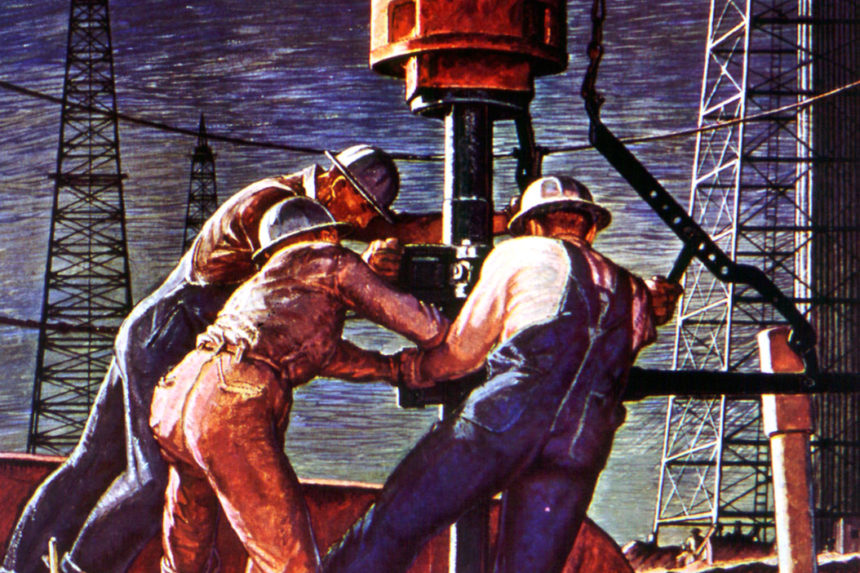When an oil rig exploded in the Gulf of Mexico in April, it produced an oil spill of roughly one million barrels of oil. It also created a tidal wave of finger-pointing, blame-flinging, and political grandstanding — the predictable events of any American disaster.
Naturally the event prompted me to look through the archives for past reports about the oil industry. I found scores of stories on the subject spanning the past century. Taken altogether, these articles present a story of America’s troubled relationship with oil and its producers.
As early as 1908, for example, the Post was criticizing Standard Oil, particularly its Vice President John D. Archbold who announced his company would be more vocal in defending its reputation.
“It was entirely unnecessary for Mr. Archbold to urge upon his readers that the Standard Oil trust is a powerful and successful commercial organization, or that it has adopted many useful and important economies in the conduct of its extensive and diversified business.
“But his denial of the often repeated charge that the business success of the Standard Oil Trust has been largely contributed to by unlawful special favors from railroad companies can hardly be accepted as conclusive, contradicted as it is by testimony in numerous cases and investigations. And when the amount and frequency of these special privileges, which have been conclusively proven to exist, are considered, the statement is clearly justified that the ability of the Standard Oil trust to defeat competition and achieve its remarkable success has been due to illegal privileges from railroad companies more than to any other one cause.
“It has been proven that during the early period of its existence it had contracts with railroad companies by which it secured a rebate of from 10% to 68% on the published tariffs of the roads on all oil that it shipped. This would have been an advantage over competitors that would have satisfied the avarice of most people. But not the geniuses of the Standard Oil Trust. They demanded and received the same amount as a rebate upon the shipments of their competitors, who were compelled to pay the full tariff rate by the railroads.”
Historically, the Post was a tireless cheerleader for development and business success. Throughout the 1920s, it heaped praise on every prospering American industry. But it never lost an ambivalence toward the oil industry.
For example, Post writer Samuel G. Blythe rhapsodized over the oil industry’s accomplishments in 1930. He proudly announced America’s oil production:
“The daily average oil output in the United States in 1929 was 3,196,000 barrels. Multiply that by 36, for oil wells, when they work, work every day. Thus we find that our total oil output in 1929 was 1,166,540,000 barrels. Almost one and one-sixth billions.”
“Oil is the giant of our national products… Oil is indispensible to our progress and prosperity. The use of it ramifies in nearly every commercial, manufacturing, distributing, motor, lubricative, heating and transport direction. It warms us and lights us. It runs our tractors and trucks and automobiles, pulls our passenger and freight trains on great railroad systems, propels our ships, whirls countless factory wheels, generates much of our power, fights our wars and flies our airplanes. The by-products of it are used in hundreds of utilitarian ways.”
Yet, at article’s end, Blythe drops his worshipful tone for one of stern warning against “the business idiocy of producing more than can be sold.” He encourages major oil-producing states to voluntarily curtail “wasteful and unneeded oil production.”
“the benefits have been clearly demonstrated. Oil can be conserved. Oil should be conserved, not because there isn’t plenty of oil but because it is sheer business lunacy not to recognize the imperative economic law of supply and demand.
“There is hope. Conservation will continue unless the oil producers are the biggest and greediest business jackasses the world has ever known.”
In a 1933 article, Harold Ickes, FDR’s new Secretary of the Interior, provided details about the wastefulness of oil exploration.
“One billion dollars is not an insignificant fortune even for the country that holds within its treasury most of the gold of the world. Yet the same people who would avidly scan tales of such a theft have permitted, practically unheeded, a loss in their oil resources amounting to much more than one billion dollars.
“We have suffered and are continuing to suffer stupendous losses in the exploitation of our oil resources. We are just as indifferent about oil as our forefather were about our forests, our plains and our streams. What if oil is being wasted? There will always be more oil; and even if it should, in time, give out, there will be plenty for our own needs in our own day. ‘May the devil take the hindmost’ is still sound American doctrine.
“I challenge any other present-day industry in the United States to show greater waste, inefficiency and mismanagement than seem to be inherent in the oil industry, whether of its own making or because of inadequate laws. These are grave charges, but they are less grave than the situation to which they relate.
The oil-drilling practices of the time, Ickes relates, encouraged drillers to grab up the easy oil, close to the surface, and leave behind the most costly oil.
“A quantity of oil on top can readily be skimmed off, and below, there is more oil clinging to rocklike sand, while still farther down in the lank there are coal and shale from which oil might be manufactured.
“If we drive a hole… a certain amount of the very cheapest oil will flow out naturally from the top. When the natural flow has ceased, it becomes necessary to install pumps in order to draw out the oil that remains stubbornly sticking to the rocklike sand. This makes the crude oil cost more. When this is gone it is now customary to abandon an oil field.
“But it may become necessary, expensive though the process will be, to go down and dig out the oil-saturated rock to wring from it oil which no pumps will bring up. It may even become necessary, at a still greater cost, to go to the bottom of our tank and dig out our coal and shale, from which, if the consumer will pay enough, it is possible to process motor fuels. “Already in many areas in the United States the cream from the top of the tank has been skimmed. The former great flush oil fields of Pennsylvania, Ohio, Kentucky, West Virginia, New York and Indiana are gone.
“Millions upon millions of barrels of oil have been allowed to become bogged in the earth’s reaches, beyond cheap recovery, because of the loss of the driving pressure of the gas.
Natural gas, rich in caloric energy, was the force that pushed oil to the earth’s surface. But the oil companies were little interested in natural gas at first. Once they realized it could be just as valuable as oil, they made efforts to capture it at the well head, instead of letting it escape into the atmosphere. However many get-rich-quick operations didn’t spare the time and money to capture this gas, but just grabbed the easy oil. The energy-rich gas was simply discarded.
“In the Panhandle of Texas, 1,000,000,000 cubic feet of gas a day go utterly to waste. Expert engineers estimate that the loss of this gas means that from 400,000,000 to 500,000,000 barrels of easily recoverable crude oil will stick in the sands. This is a direct loss of crude oil sufficient to supply the entire nation for approximately six months.
“From 200,000,000 to 250,000,000 barrels of gasoline could have been made from that crude oil. Enough is being lost in that one field to fill up every car in the country more than forty times.
“A year’s output of that wasted gas — 365,000,000,000 cubic feet — represents as much heat energy as 62,634,000 barrels of fuel oil—enough to heat the average home 1,252,680 years, or, to turn it around, to heat 1,252,680 homes a year. The staggering total of 62,634,000 barrels of fuel oil is difficult for most of us to grasp. But it would heat every home in Cleveland for three years. Dallas, Texas has 83,000 homes, every one of which could be heated for 132 months. Likewise every home in Atlanta, Minneapolis, Portland, Oregon, Providence, Erie, Lansing, Topeka and Racine could be kept warm for a whole twelve months’ year, not just the winter season.
“Some of the early wells in Michigan were allowed to spew 18,000,000 cubic feet of gas a day, each, into the air. Visualize the worth of that gas if piped into Detroit or Lansing to make automobiles, or into Chicago for use as fuel. Just as a measuring rod, consider that our capital city of Washington consumes for domestic and industrial purposes approximately 7,000,000,000 cubic feet of gas a year.
“My own opinion is that if the oil industry cannot control its affairs in the public interest, then the Federal Government, of necessity and to protect all the people, must take a hand. This business of oil is so important to all of us that private control must promptly and drastically mend its ways. We must, as a people, have oil, and plenty of it, at reasonable prices from our own wells. We cannot continue recklessly to pour this precious resource over the whole world. One can almost hear the sardonic laughter of nations, jealous of our prestige and covetous of our wealth, as they watch our headlong course toward national bankruptcy in oil while they count every drop of their own hoarded stores of this precious mineral.”
Over the next forty years, critics kept up their demands that oil companies use less wasteful methods. The companies had little interest in the arguments until the 1970s. To be fair, the oil companies would have had little incentive to reduce waste in the early 20th Century. As far as they could see, there was a nearly unlimited wealth of inexpensive oil in the 1930s — far more than would ever be needed by America’s 26 Million cars and trucks. (The number of vehicles has grown 1,000% since then.)
In 1970, though, America’s supply of cheap oil began to disappear, and we became more reliant on foreign oil. Suddenly the industry was working hard to extract every bit of oil and gas at every well head. And, as the oil executives, critics, and politicians had expected, energy prices rose.
I’ll close the first part of this Retrospective with a nostalgic glimpse at historic gasoline prices.
Oh, those happy days.
| Decade | Avg. Gallon Price |
| 1950s | 19¢ – 26¢ |
| 1960s | 31¢ – 35¢ |
| 1970s | 36¢ |
| 1980s | $1.00 |
| 1990s | $1.10 |
| 2000s | $1.65 – $4.00 |
Read “This Billion Barrel Oil Country” by Samuel G. Blythe [PDF].
Read “After the Oil Deluge, What Price Gasoline?” by Harold Ickes [PDF].
Next:
America’s Common Wealth of Energy: The Long Battle for Oil Conservation
Become a Saturday Evening Post member and enjoy unlimited access. Subscribe now




Comments
Americans got hooked on oil,
Early and often as oil is
The life blood for all play and toil.
We put the big in big oil biz.
Americans care not of waste,
As long as we get all we crave.
Hypocritical and two faced,
We preach to others what to save.
Americans pigged out at home,
Then went on sprees around worldwide.
The fall of the empire of Rome –
We are slipping down the same slide.
Americans won’t sacrifice
Craving for oil at any price.
Apparently, everyone from left-leaning, know-it-all journalists to power-seeking political bureaucrats know the oil business. Everyone, that is, except oilmen.
Given any other choice, no rational oil explorer would opt for the perils of deep-sea drilling. Because of unrealistic and unending government sanctions against taking oil where it is far less hazardous to get, the Gulf of Mexico is now filling with oil.